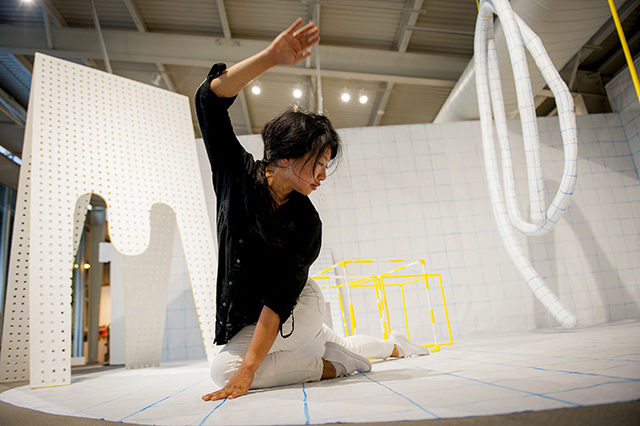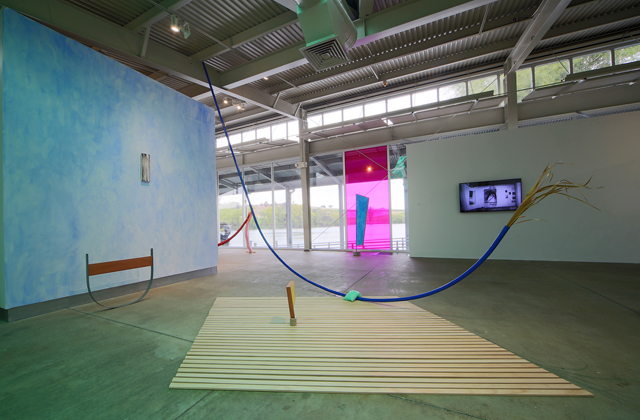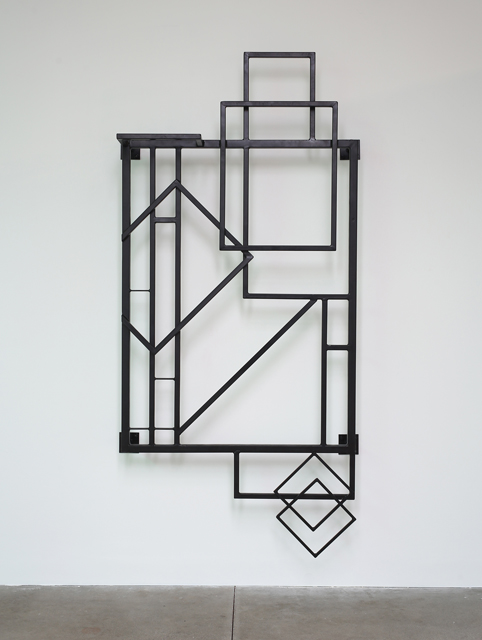Tucked away among vineyards on Napa’s Carneros Highway is di Rosa, currently presenting Body Talk, a group show of six emerging Northern California artists and collectives. Performance, the most ephemeral and bodily of visual art practices, activates much of the artwork on view. On Aug. 1, the opening reception for Body Talk included performances across the exhibition space, and the closing reception on Sept. 26 will again enliven the work. This emphasis on live performance might make visiting the static gallery space feel incomplete, but this tension is worth exploring.
Manners’ Basic Edition (2015) and Bonanza’s they know better (2015), take up entire ceiling-to-floor corners of the space, evoking colorful, minimalist playgrounds. This reference to play is not incidental; these particular spaces were designed with imaginative physical movement in mind. Curator Amy Owen describes the premise behind Body Talk as a gathering of artwork that attends to physical movement, including performance, dance and aerobics, in contrast to our digitally-oriented lives. This theme is in response to society’s “disembodied” reliance on technology, in which the act of swiping left might be to the closest to exercise we get.

In Manners’ corner, hand-drawn gridded paper covers the floor and extends up to the rafters. Scattered yellow cubes and a flat wood sculpture, roughly shaped into a bent human form, stand within the space. Fabric tubes, also gridded, hang from above. Manners is a collaboration between Sophia Wang and Lisa Rybovich Crallé, artists who created Heavy Breathing, a series of workshops held across the Bay Area this summer that merge critical theory with fitness classes. This conceptually-linked installation likewise anticipates movement; Wang performed on site at the opening reception. Without access to documentation of that performance, di Rosa visitors are left wondering and imagining what types of dance or exercise could take place here.
Across the room, the collective Bonanza (Conrad Guevara, Lindsay Tully and Lana Williams) assembles eclectic sculptural pieces and gel window-coverings to create an unusually serene environment. A teal-tinged skylight illuminates a simple wooden platform, and irregular rectangle-shaped canvases held up by concrete cylinders sit on the floor. Although the exhibition brochure references the malleability of stretching and yoga poses, the peacefulness of this artificial environment holds its own weight.

Exercising Grill (2011) by Mads Lynnerup similarly merits traditional contemplation on its own aesthetic value, but expects a bodily engagement. The steel structure of squares, rectangles and parallel lines is firmly mounted to the wall. The work is meant to be climbed upon (by commissioned professionals), as demonstrated by nearby video footage. One wonders if this is artistically-designed workout equipment or a vehicle for endurance-based performance. And then, what’s the actual difference between the two?
In contrast to the artwork that might require bodies, May Wilson’s sculptures playfully create an uncanny liveliness. A fleshy vinyl tube suspends from the rafters in Staunch (2015), companion to a homely “creature” that stands on three bowed legs. Made of woven pink felt, the torso or head of this apparition slouches forward precariously. One half-expects it to lurch forward with a shuffling gait, or reveal a Muppet-like face underneath the folds.

Work less clearly aligned with the exhibition’s theme is Shoulder Babies (2015) by Christian and Kevin Nagler. In a single-channel video in a separate screening room, the brothers’ piece documents what seems to be a durational performance alongside a Silicon Valley highway. As an extension of Christian Nagler’s ongoing investigation into capitalist economics through exercise and dance, this piece is particularly difficult to follow. As day turns into night, two figures wearing yellow body suits wander, frolic, dance and discourse opaquely. The conversation that is audible offers little insight into the work. Although perhaps intentionally confusing, the video seems like an instance in which performative work loses its punch through edited documentation.
The tricky curatorial task of assembling performance work is highlighted by the complete absence of any trace of Renée Rhodes until the closing reception on Sept. 26. Her forthcoming performance, Visitor Center, is described as a “workshop and series of site-specific performances.” While hosting a one-time performance in conjunction with an exhibition is common practice, in the context of this exhibition the absence is striking.
Throughout Body Talk is a definite lack of bodies. Even without flesh and blood performers, the clean minimalist aesthetics of Manners and Bonanza trump figurative work, and Wilson’s sculptures are only body-ish. When talking about bodies, how does the absence of actual bodies impact the conversation? Body Talk is content to leave this question unanswerable, serving more as a sampling of artists who contemplate the temporary, performative and spatial experiences of bodies with restraint. Although much of the artwork stands alone without being activated, it’s clear that witnessing the relevant performances will offer a more enriching experience for viewers.